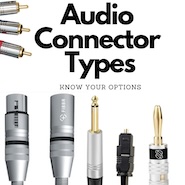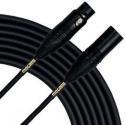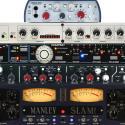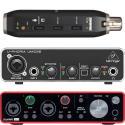Understanding Line Level in Audio
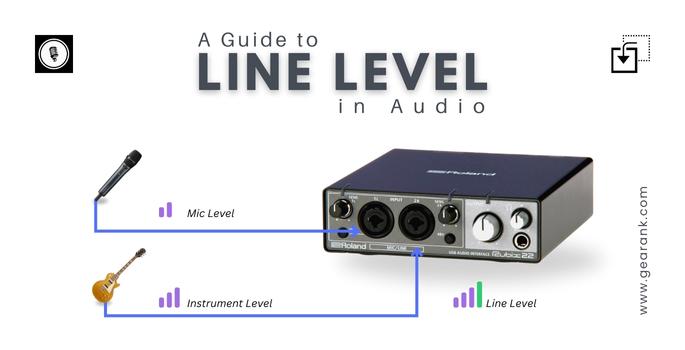
In this article, we will focus on the line-level signal and its role in professional audio. Line level is one of the four fundamental signals for connecting audio devices.
It comes along with mic level, instrument level, and speaker level. Most professional and consumer audio equipment runs on line-level signals.
This guide will explore the line-level audio signal in more detail. I'll explain what this means, how it works, and why it matters.
Understanding these concepts regarding line-level signals is critical to achieving professional quality results.
Before we dive into line-level signals, let's first look into what audio signals are.
What's An Audio Signal?
Audio signals are the voltage generated by mics and instruments. They are the electrical equivalent of audio, which is passed around to professional audio equipment. This includes devices such as amplifiers, interfaces, mixers, and speakers in a sound system.
To ensure proper connectivity, sound engineers must understand various signals in audio. and their relation to each piece of equipment.
Professional equipment for audio generally falls into four categories. Instrument, speaker, mic, and line levels. Each with its own specific voltage and compatibility requirements.
These levels include line levels, which are measured in dBU or dBV. For example, a device that requires line levels should not be connected to gear that operates at instrument levels.
An audio signal mismatch will cause clipping or distortion in the signal. You'll hear this as unwanted noise in the sound or a noticeable reduction in audio quality. Aside from sound quality issues, mismatches can also damage your equipment.
Audio Signal Processing
The audio signal chain starts with a source, which can be a voice or an instrument that generates a mechanical signal. This signal is then picked up by a microphone or the pickup of an instrument.
Mic-level signals have low impedance, while instrument-level signals (including electric guitar models with passive pickups) have high impedance or hi-z. To function properly, these signals are converted to line-level, which is the standard in which most professional audio equipment operate in, including mixers, external effects, and amplifiers.
This standardization ensures compatibility and optimal performance across a variety of audio devices in a typical recording or live sound setup.
In the conversion process, preamplifiers (preamps) play a vital role. Preamplifiers, often found in audio interfaces, mixing consoles, or dedicated preamp stage units, convert the mic or instrument-level signals into line-level, ensuring that they meet the necessary voltage and impedance criteria for seamless integration into the broader audio system.
This transformation facilitates efficient signal flow within the audio chain and also enhances the signal-to-noise ratio, maintaining the integrity of the original sound throughout the subsequent stages of processing and amplification.
What is a line-level Level Signal in Audio?
A line-level signal is a standardized electrical voltage representing an audio signal at its full strength, typically around -10 dBV to +4 dBu.
This signal level is optimal for connecting various audio devices in a professional audio system, such as mixers, amplifiers, and other outboard equipment.
The conversion of signals into line level involves adjusting the voltage and impedance characteristics of the signal to match the standard requirements of line-level signals. Preamps play a crucial role in this process, providing the necessary gain and adjustments to bring the signal to the desired level for further processing and amplification.
Why is Line-Level Signal Important in Professional Audio?
A line-level signal is crucial to operating most audio equipment; here's why.
Standardization: As an audio engineer, adjusting the signal chain line level for compatibility is important. The audio engineer ensures that audio components work well together, so a standard line-level signal is required.
Line level is the standard signal with which most audio devices operate. It allows each audio device to work seamlessly while simplifying the connecting process.
Minimizes Noise and Distortion: A line-level signal has enough voltage and impedance, which helps minimize signal distortion and audio interference during transmission.
This is crucial to maintaining the integrity and quality of the audio as it passes through each device in the chain. As a result, you get a clearer audio signal even when it travels a longer cable distance.
Separates Signal Processing Stages: In audio systems with separate preamp and power amp sections. Line-level signals facilitate the separation between each processing stage.
The preamp takes care of the signal conditioning and volume control. While the power amp stage amplifies the signal further to drive the speakers.
The Two Standards Line Level Signals Operate In
There are two standards to define line-level signals. This depends on the equipment you'll be using: consumer equipment and professional audio gear.
For the consumer line level, the standard operating level is -10 dBV. DVDs, CD players, and other home stereo equipment operate on this level. Most consumer audio devices are unbalanced and are connected with either two RCAs or a 3.5mm (1/8") TRS minijack connector.
The standard operating level for professional line level, on the other hand, is +4 dBu. This is where most pro audio equipment, such as mixers, amplifiers, or outboard effects, operates. Pro audio equipment typically has balanced connections and requires 6.35mm (1/4") TRS phone or XLR connectors.
Why Is Knowing This Important?
Without going into much detail, professional audio equipment is designed to send and receive high-quality audio signals. It equates to 12 bBu higher than what a consumer device can handle.
Knowing this is essential, especially if you're connecting both a professional and a consumer device in one signal chain.
For example, if you're sending a signal from a professional to a consumer device. You must decrease the output of the professional audio device or use a signal pad/attenuator between them. Without decreasing the signal level, you'll run the risk of overloading the input of the consumer device since it's not built to receive such a load.
Similarly, let's say that you're sending a signal from a consumer device to a professional device. In this case, it is not possible to increase its output without clipping the signal.
What you can do instead is increase the gain at the line input of the professional device or use an in-line signal-level driver. However, keep in mind that increasing the level of the signal in this manner will also increase the level of the noise floor beneath that signal.
Final Thoughts
In the world of pro audio, line-level signals play a crucial role. It serves as the standard format and serves as a link between audio devices.
It facilitates the smooth and seamless communication of audio equipment, from minimizing the noise to separating the signal processing stages.
Line-level signals ensure the clarity of the signal in audio processing. By helping maintain signal integrity, you get quality audio with less distortion and minimal noise.
Frequently Asked Questions
What Is A Line Level Mismatch?
A mismatch happens when you try to connect the wrong source to the input of an audio device.
Various input sources (like a mic input and instrument input) are designed only to accept specific incoming signal levels. Which means that you cannot use varied levels for the same input source.
As an example, you cannot connect a microphone-level source to a line-level input. This usually results in no sound coming from your system. Others will result in a noisy signal or damage your equipment.
What Is the Difference Between Mic, Instrument, Line, and Speaker Level Signals?
The main differences between mic level vs line level vs instrument level vs speaker level lie in their voltage. A mic-level signal voltage varies from -40 dBu to -60 dBu, while a line-level signal is around 10 dBV to +4 dBu. Instrument level lies in between the mic and line level ranges.
The speaker-level signal is the strongest, which it needs to properly drive the speakers. Specific speaker connector types are needed to connect the speaker outputs of audio devices.
Mic-level and instrument-level signal inputs come from a source. It's usually in the form of a mechanical signal from a microphone or an instrument.
A line-level signal is used to channel audio signals between the different audio equipment. While the speaker level is what drives the speakers to sound.
TRS vs TS Connectors: What's Their Difference?
A TRS connector is balanced, as is usually used in connecting different audio gear. A TS connector, on the other hand, is unbalanced and commonly used to connect instruments to audio equipment.
The initials on both the initials of these terms represent a tip, ring, and sleeve. The tip is what sends the audio signal. The ring is an internal conductor used for balanced signals.
Lastly, the "s" stands for sleeve, which connects with the ground wire to protect the signal from interference.
Contributors:
- Jerome Arcon - Co-writer
- Jerry Borillo - Illustrator




